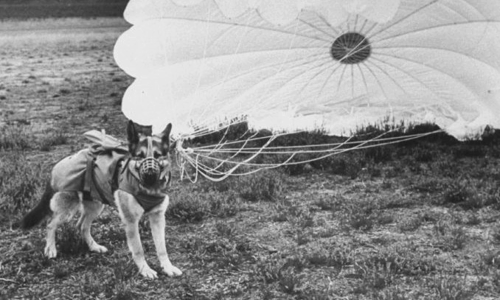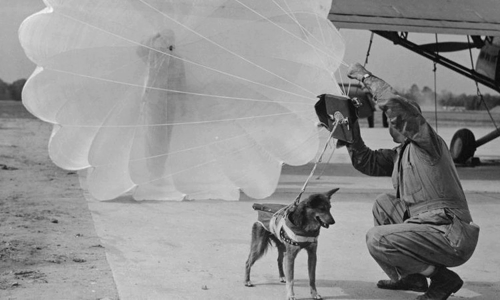The British Army trained parachute dogs from aircraft to assist infantrymen to take advantage of the Normandy landings in 1944.
The Allies tried to take advantage before the largest landing in history to capture the Normandy beach from Nazi Germany in June 1944. One of the ideas thought to be crazy but still deployed by the British army is the "skydiving dog" project.

A dog in parachute training Photo: Der Spiegel
The British 13th Parachute Battalion decided to allow the dogs to take part in a special training course to turn them into "dogmasters" capable of parachuting into war zones. With their ability, they will play an important role in fighting infantry, sniffing enemy bases, identifying minefields, realms and helping soldiers maintain their fighting spirit.
In order to recruit the necessary dogs, the British army called for help from the people. Faced with wartime food shortages, many British families are willing to donate their dogs to the military to reduce a "mouth to eat" indoors.
The dogs were quickly screened to select "militaries" that could be used for combat. The War Dog Training School was also established in Herfordshire in 1941 to train dogs.
These dogs are systematically trained to detect mines, identify the smell of gunpowder and explosives, identify traps, move with soldiers and most importantly withstand explosions. and loud sound.
They are constantly accustomed to loud noises by sitting on mechanical transport for several hours a day for a month. The "military dog" also often hear gunshots and smell the real smell on the battlefield. This helps them not to fear and run wild when fighting.
Dogs that pass this training will be trained on landings by tying their parachutes to the body and dropping them off the plane. They starved themselves for a while, then parachuted with their trainer, who carried a piece of meat to help them stay awake and obey.
"After taking the umbrella, I saw Ranee above and about 30 meters away. Although it was open, it looked bewildered but fearless. I called and Ranee immediately looked at me waving her tail in greeting. landing in front of me, it was completely comfortable and had no problems. I landed nearby and helped him remove the parachute and feed him, "said the first soldier Ken Bailey, recording the training process of" military dog "Ranee.

British paratroopers check on a dog's equipment Photo: Der Spiegel
This project seems to be very successful when the dogs are carefully trained to calmly face the dangers on the battlefield.
On June 5, 1944, the 13th Airborne Battalion launched its mission with the dog army. Each aircraft was composed of 20 soldiers and a dog, all of which were dropped out of a mechanical bombardment amidst the flare of German anti-aircraft artillery shells. Many stories about the courage of parachute dogs were later told by soldiers.
One of them is a dog named Bing of the German Shepherd-collie. When the plane entered the enemy airspace and anti-aircraft artillery shells exploded, Bing panicked, hiding in the tail of the aircraft but was still thrown out by the trainer when he arrived at the battle site.
After parachuting, Bing was wounded by German anti-aircraft artillery shells, but it still landed safely and then showed great skill when detecting enemy mines, saving many Allied soldiers. .
Bing then took part in another air campaign, parachuting to the rear of Nazi Germany to join the Allied soldiers. After landing, Bing was sent to inspect a house suspected of being a German soldier's refuge and promptly warned of the danger for the soldiers to accompany.
For this achievement, Bing was awarded the Dickin Medal, the highest reward for the animals in the British army. It was reunited with its former owner after World War II ended. Bing died in 1955 and was buried in a special cemetery near London, and the statue is located in the Paratroopers Museum in Duxford.



 GingerBugielski
GingerBugielski







